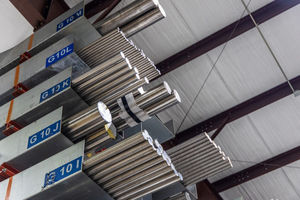

- Products
- Catalogs
- News & Trends
- Exhibitions
Titanium rod 6AI-4VtubemedicalASTM B348
Add to favorites
Compare this product
Characteristics
- Shape
- rod, tube
- Other characteristics
- medical, ASTM B348, ASTM B265, ASTM B861, AMS 4928, AMS 4911
Description
6Al-4V titanium is the most widely used of all the alpha-beta titanium alloys. It is typically used in the annealed condition, at service temperatures through 750°F. However it may be heat treated for high strength in sections under 4″ thick. Hardenability is limited and sections over one inch may not develop full properties. Ti 6Al-4V is welded with matching or with ELI filler wire.
Mill anneal: 1300-1450°F 2 hours, air cool. Recrystallization anneal bar for better ductility and fatigue strength, 1750°F 2 hours, furnace cool.
For maximum fracture toughness and SCC resistance: Beta anneal 1950°F 1-2 hours, water quench. Then age 1150-1300°F 2 to 4 hours, air cool.
For maximum strength: solution-treated and aged (STA) condition is: For sheet, 1675-1725°F 5 to 25 minutes, water quench. Age 975°F 4 to 6 hours, air cool. For bars and forgings, 1675-1725°F 1 hour, water quench. Age 975-1025°F 3 hours, air cool.
For increased fracture toughness, but lower tensile strength: precipitation treat (overage) 1150-1250°F 4 hours, air cool. Stress relief annealing is commonly 1000-1200°F 1 to 4 hours, air cool.
Ti 6Al-4V is resistant to general corrosion but may be quickly attacked by environments that cause breakdown of the protective oxide. These include hydrofluoric (HF), hydrochloric (HCl), sulfuric and phosphoric acids. Inhibitors may help for the last four but not for HF. Ti 6Al-4V resists attack by pure hydrocarbons, and most chlorinated and fluorinated hydrocarbons (provided water has not caused formation of small amounts of HCl and HF).
*Prices are pre-tax. They exclude delivery charges and customs duties and do not include additional charges for installation or activation options. Prices are indicative only and may vary by country, with changes to the cost of raw materials and exchange rates.


